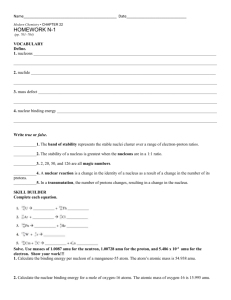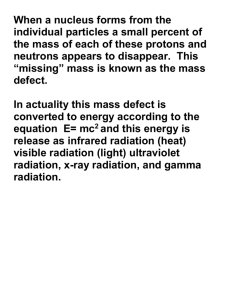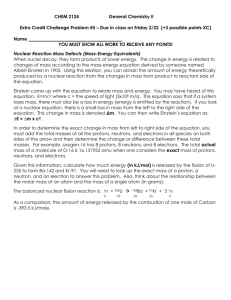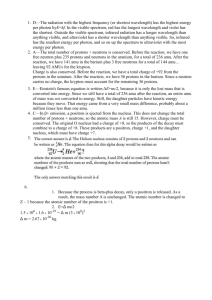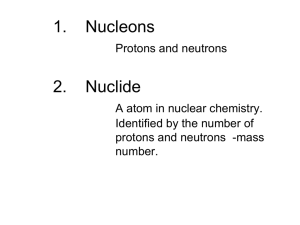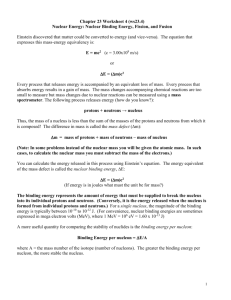Nuclear Chemistry Section 1 powerpoint notes
advertisement
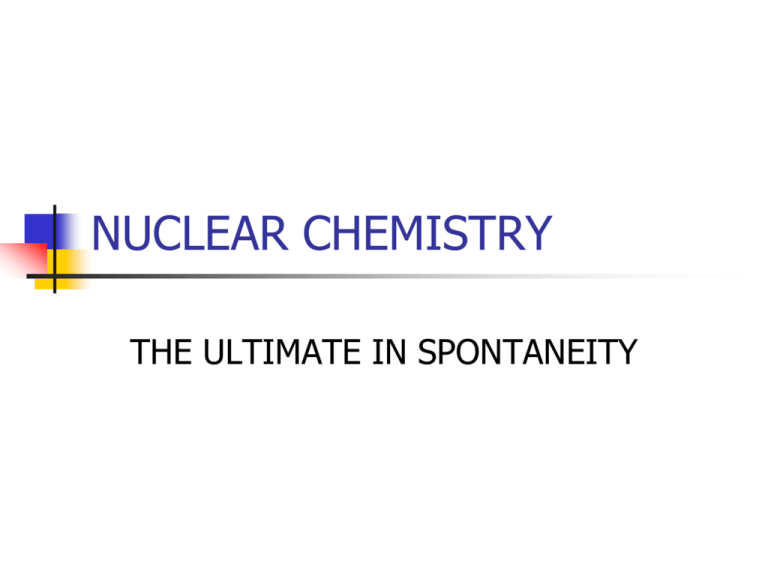
NUCLEAR CHEMISTRY THE ULTIMATE IN SPONTANEITY Review Atomic number (Z) – number of protons Mass number (A) – sum of the protons and the neutrons Nuclides– atoms with the same atomic number but different mass numbers, different numbers of neutrons. (Isotopes) Nucleons – the particles that make up the nucleus. (protons and neutrons = mass #) Facts about the nucleus Very small Very dense Held together by the nuclear strong force Location of the protons and neutrons Most of the mass of an atom is located Mass Defect The difference between the calculated mass and the actual mass is known as mass defect. calculated mass is the sum of all of the subatomic particles that make up the atom. What causes the lost mass? According to Albert Einstein, mass and energy can be converted into each other. Some of the mass is lost during the formation of the nucleus. The amount of energy can be calculated using Einstein’s famous equation. Nuclear Binding Energy The energy released when a nucleus is formed from nucleons. E = mc2 E is for energy unit: Joules (J)=kg.m2/s2 M is for mass unit: kilograms (kg) C is the speed of light (squared) 3.00 x 108 m/s Binding Energy per Nucleon The binding energy per nucleon is used to compare the stability of different nuclides. It is the binding energy of the nucleus divided by the number of nucleons that are in the nucleus. Binding Energy The higher the binding energy per nucleon, the more tightly packed the nucleons are held together, the more stable the nuclide. "A is for atom" (1952) video Mass Defect Example Problem What is the nuclear binding energy per nucleon for lithium-7. The measured mass of lithium-7 is 7.01600 amu. First determine the calculated mass of lithium -7 from the mass of the protons, neutrons and electrons Mass Defect Protons 1.007276 amu Neutrons 1.008665 amu Electrons 0.0005486 amu Mass Defect 3 protons x 1.007276 amu = 3.021828 amu 3 electrons x 0.0005486 amu =0.0016458 amu 4 neutrons x 1.008665 amu = 4.03466 amu Add these up and subtract by the measured mass 7.05665 amu - 7.01600 amu = 0.04065 amu This is the mass defect of one atom Mass Defect The mass defect is in the wrong unit Second: convert amu into kg (the SI unit for mass) 1 amu = 1.6605 x 10-27 kg 0.04065 amu x 1.6605 x 10-27 kg 1 amu = 6.7499 x 10-29 kg Nuclear Binding Energy Third: Now your ready to calculate the nuclear binding energy! E = mc2 Plug in your mass defect value in kg E = (6.7499 x 10-29 kg) (3.0 x 108 m/s)2 = 6.0749 x 10-12 J This is the nuclear binding energy for one atom Nuclear Binding Energy per Nucleon Last: divide the nuclear binding energy by the number of nucleons (mass #) 6.0749 x 10-12 J 7 = 8.6784 x 10-13 J/nucleon Nuclear Binding Energy Elements with intermediate atomic masses have the greatest binding energies per nucleon and are therefore the most stable. Iron is the most stable isotope. Binding Energy per Nucleon How does the nucleus stay together? Relationship between the nuclear strong force and the electrostatic forces between protons. Like charges repel each other through electrostatic repulsion How does the nucleus stay together? The nuclear strong force allows protons to attract each other at very short distances. As protons increase in the nucleus so does the electrostatic forces, faster than nuclear forces. Why do atoms want more neutrons than protons? More neutrons are required to increase the nuclear force and stabilize the nucleus. > 83 the repulsive forces of protons is so great that no stable nuclides exist. Band of Stability Stable nuclides have certain characteristics When the number of neutrons are plotted against the number of protons a pattern is observed Band of Stability The neutron-proton ratio of stable isotopes cluster around a narrow band called the band of stability. For atoms with low atomic numbers the ratio is 1 : 1 As the atomic number increases, the ratio increases to 1.5 : 1 Band of Stability Magic Numbers Stable nuclides tend to have even numbers of nucleons. 256 stable nuclides 159 have both even protons and neutrons Only 4 have odd numbers of protons and neutrons. Nuclear Shell Model Nucleons exist in different energy levels, or shells, in the nucleus. The number of nucleons that represent completed nuclear energy levels, 2, 8, 20, 28, 50, 82, and 126 Called magic numbers Nuclear Reactions Unstable nuclei undergo spontaneous changes that change the number of protons and/or neutrons. Give off large amount of energy by emitting radiation during the process of radioactive decay. Nuclear Reactions Eventually unstable radioisotopes of one element are transformed into stable, non-radioactive, isotopes of a different element. Total of mass number and atomic number must be equal on both sides of a reaction. Nuclear Reactions When the atomic number changes, the identity of the element changes. A transmutation is a change in the identity of a nucleus as a result of a change in the number of protons. Nuclear Reactions Mass Number’s must equal on both sides of the equation. 14 0 14 C 6 e -1 + N 7 Atomic number’s must equal on both sides of the equation Nuclear Reactions Try one! 238 4 U He + 92 2 _______ Nuclear Reactions Try one! 238 4 234 U He + 92 2 Th 90
